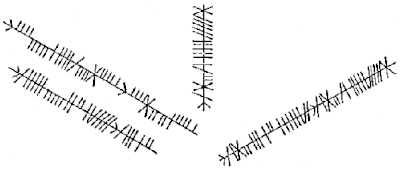Ballyspellan brooch
The Ballyspellan Brooch (CIIC 27) is an archaeological find discovered in 1806 by a farmer digging on the hill in the townland of Ballyspellan ( Irish Baile Uí Spealáin ), County Kilkenny , Ireland . There is a ring brooch made of silver with a 25.2 cm long needle. Four lines of Ogham inscription are incised on the back of the needle . Due to the type of ornamentation, the fibula is dated to the 9th century AD. The find is kept in the National Museum of Ireland in Dublin .
inscription
The Ogham symbols are neatly carved into the back of the Ballyspellan brooch. The starting arrows typical of many Ogham inscriptions (running to the right), which also indicate the reading direction, are used before each new word. For the sound E, with one exception (first E in CNAEMSECH), a forfid is used, which is also used in other inscriptions for the sound sequence EA and which looks like X. The Irish archaeologist RAS Macalister suspects the names of the successive owners of the primer in the four lines.
Transmission and translation:
- CNAEMSECH CELLACH
- Cnaemsech, (son of) Cellach
- MINODOR MUAD
- Minodor, the noble one
- MAELMAIRE (the first A is missing in the tracing)
- Mael-Maire
- MAELUADAIG MAELMAIRE
- Mael-Uadaig, (son of) Mael-Maire
Specialty
The Ballyspellan Primer is one of the only eleven rare small finds mentioned in the Ogham specialist literature to date, i.e. finds in which the Ogham characters are not carved into stone slabs and stone pillars (around 400), but into small objects (mainly everyday objects). Six of these, including the Ballyspellan primer, were discovered in Ireland, namely the Ballinderry cube , the Dublin Castle comb , the Ennis pearl , the Kilgulbin hanging bowl and the Tullycommon bone .
literature
- Macalister, RAS (Robert Alexander Stuart) : Corpus Inscripionum Insularum Celticarum 1, Dublin 1996 (reprint from 1945)
- Mahr, Adolf: Irish Early Christian Handicraft, in: NMAJ (North Munster Antiquaries) Vol. 1 / No. 2 (1937), p. 57 - p. 66
Web links
- Photo after p. 67 on Plate 7, No. 7 (in the middle of the page)
- Another photo
- Description of the Ballyspellan Primer on the website of the National Museum of Ireland
References and comments
- ↑ Designation generally used in specialist literature according to R. A. S. Macalister's numbering in his standard work "Corpus Inscriptionum Insularum Celticarum" from 1945, which is still cited today (reprint 1996)
- ↑ Macalister, p. 32
- ↑ logainm.ie
- ^ Website of the Irish National Museum
- ↑ Macalister, p. 32 and website of the Irish National Museum . Buchanan et al. a. however, date the garment needles from the end of the 11th century to the middle of the 12th century; see. Buchanan, pp. 50 - 51
- ↑ A "Forfid" ( singular form ; plural "Forfeda") is one of the additional characters created after the 20 original Ogham characters.
- ↑ Macalister, p. 32
- ↑ Macalister, p. 32
- ↑ Mentions and descriptions e.g. B. by Donal B. Buchanan , Katherine Stuart Forsyth , Robert Alexander Stewart Macalister , Barry Raftery
